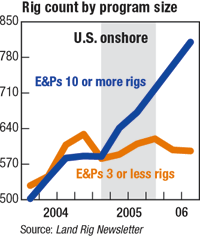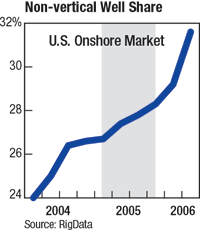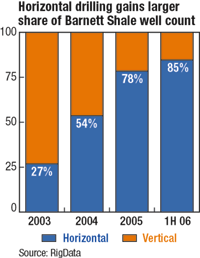North American Outlook
New rig construction targets onshore unconventional resources
Unconventional onshore US drilling is driving mergers, rig utilization, drilling techniques and innovative rig designs. New designs may bring the next step improvement in productivity gains as drillers embark on the largest retooling effort in 25 years.
Richard Mason, Publisher, The Land Rig Newsletter
The onshore market is undergoing a rapid transition to unconventional oil and gas as a primary target. Advancements in drilling and completion technologies, including fracture stimulation and horizontal/ directional drilling, coupled with high commodity prices, are generating access to tight-formation resources that were considered uneconomic as recently as three years ago.
US contractors are working in partnership with oil and gas operators to develop fit-for-purpose modern technology land rigs, financed through multi-year term contracts. A significant and increasing portion of this equipment will be used in exploiting hydrocarbon resources in tight sands, shales and coalbed methane deposits in the US onshore market.
These resource plays feature low geologic risk and rely on engineered solutions, economies of scale and repeatability to produce declining well costs, after operators overcome an initial learning curve that may involve up to 100 wells or more. As a result, efforts to gain additional productivity in onshore drilling are now focused on design innovations and technology improvements on newbuild land rigs that capture incremental time savings during all phases of the well drilling process, including moving between wells.
UNCONVENTIONAL FORCES
Precisely defining the size of the onshore unconventional market is a challenge. Cross-referencing well activity from Fort Worth-based RigData with known unconventional plays suggests drilling in tight formations represents 39% of well activity as of mid-June 2006. This process involved very conservative methodology, however, and the actual level may be closer to 50%. Unconventional drilling is therefore either closing in on, or supplanting, conventional activity as a majority employer of domestic land rigs.
Mergers and acquisitions are being affected by the transformation to unconventional targets. Consider the "unconventional" element in mergers and acquisitions in recent years, such as Devon/ Mitchell, EnCana/ Tom Brown, Kerr McGee/ Westport, Noble/ Patina, Pioneer Natural Resources/ Evergreen, ConocoPhillips/ Burlington Resources and Anadarko/ Western Gas Resources/ Kerr McGee. Although not the only acquisitions involving onshore unconventional oil or gas, these examples, alone, represent more than $68 billion in deals.
 |
Fig. 1. Rig activity by program size.
|
|
Rig activity is rising as a response to the transition to unconventional oil and gas. My newsletter has published studies of rig counts which show that about three dozen E&P firms, each with 10 or more active rigs, have been responsible for a majority of rig activity increases over the last two years. The methodology involves segregating rig activity by program size to better understand market dynamics. Historically, small E&P firms were a primary determinant in rig market tightness. These firms tended to pull back during the first half of the calendar year, then rush in during the second half, repeating the process annually. This pattern changed after 2004.
Rig activity comparisons and be made between small E&P firms and the most aggressive growth-through-the-drill-bit companies, Fig. 1. Small firms are often represented by operators employing three rigs or less. These E&P firms’ rig use has remained essentially flat, with seasonal variations, since the first quarter 2004. It is interesting that companies employing just a single land rig generally account for more than 62% of all active E&P firms, but represents just 23% of the rig count.
Conversely, the largest share of the rig count comes from companies that employ 10 rigs or more. These aggressive growth-through-the-drill-bit companies added over 325 rigs to the employment rolls in just 30 months after the first quarter 2004. Although this group is easily less than 10% of all operators employing land rigs, it accounts for nearly 50% of rig employment in the current market. Often, these large capitalization E&P firms and super-independents are also major players in unconventional plays like the Barnett Shale or the Piceance basin.
Additionally, unconventional plays are expanding rapidly as operators apply technology to unlocking new production in the Delaware basin in West Texas, the Woodford Shale in Oklahoma and Texas, and the Fayetteville Shale in Arkansas. Each of these plays involves new rig construction and/or drilling capacity additions under multi-year term contracts.
While specific information on contract terms remains closely held for competitive reasons, it is possible to deduce that growth-through-the-drill-bit E&P firms are the primary customers. Basin resource plays involve little geologic risk. The risk is in completion. Furthermore, tight formation production emphasizes consistency in drilling performance through repeatability, which ultimately generates cost reductions over time through scale economies. As a result, it makes economic sense for operators to underwrite new rig construction, and then employ the units through multi-year term contracts in the "harvest" mode that characterizes unconventional oil and gas production. These new drilling units are easily scaled or adapted to the specific requirements of customers, whether the demand is for pad drilling applications or highly mobile drilling units.
 |
Fig. 2. Non-vertical well market share.
|
|
|
| |
 |
Fig. 3. Barnett Shale horizontal drilling.
|
|
|
Another way to measure the transition to unconventional oil and gas involves tracking market share for horizontal/ directional drilling. This onshore drilling segment serves as a rough proxy for unconventional activity. Non-vertical drilling represented 26% of well activity in 2005, according to RigData. It now exceeds 31% at mid-year 2006, Fig. 2. On a nominal basis, year-over-year improvements in quarterly rig counts show non-vertical drilling rising from an average of 400 rigs per quarter in early 2005, to more than 600 units active in mid-July 2006. While vertical well drilling grew 49% on a quarterly average basis between the first quarter 2004 and the second quarter 2006, non-vertical drilling rose by 119%.
The change is better illustrated regionally. In the Texas Barnett Shale, horizontal drilling represented about one in four wells in 2003. For 2005, horizontal drilling had grown to 78% of all well activity, and that number is above 85% for the first half of 2006, Fig. 3. Similarly, directional drilling rose from 38% of well activity in Colorado in 2005, to 54% during the first half of 2006.
Horizontal and directional drilling have become a means to apply well stimulation and completion practices with greater precision to gain maximum advantage in exploiting tight formation oil or gas. More often than not, these practices will be using fit-for-purpose modern technology rigs with top drives, AC power systems, and greater hydraulic horsepower packages as platforms for delivery.
NEW DESIGNS
Modern technology rigs feature greater automation in drilling via software-operated Programmable Logic Controllers (PLCs), top drives, automated tubular handling, AC power systems, satellite voice and data transmission, and faster mobilization through modularity and trailerized rig designs.
An example is the new FlexRig4-S from Helmerich & Payne IDC, a skidded, self-moving pad drilling unit that can drill up to 24 directional wells from a single surface location. Another is National Oilwell Varco’s RapidRig, a 1,000-hp AC unit designed specifically for general drilling in the shallow to mid-depth US land market. IADC’s Drilling Onshore America Conference featured presentations of new technology rigs fabricated in Italy and China, as well as testimonials about these rigs from E&P firms that have established drilling divisions.
A majority of these units are mid-depth rigs with ratings in the 6,000 to 12,000-ft range. Nearly all feature larger mud pump hydraulic capacity compared to traditional rig configurations, and are ideally suited for non-vertical drilling applications in unconventional oil and gas plays. The units offer customization through scalability and can be outfitted with ancillaries like air or coiled tubing packages.
Part of the evolution involves smaller components that provide similar performance to traditional equipment. This reduces weight, size and cost, and can add to efficiency. Several rigs use Range III pipe and automated pipe handling. On the rig floor, automation consists of iron roughnecks, while automation off the floor involves cranes or forklifts, combined with automated pipe handling through booms. Automated pipe handling is becoming a common feature on many, if not most, new rigs, including the already mentioned FlexRig4 and Rapid Rig, as well as Italy’s Drillmec HH-300, Nabors Industries’ PACE rigs, and Ensign Resource Service Group’s ADR unit. A similar innovation involves the Dutch-built Huisman-Itrec LOC 250, a casing-while-drilling rig that is working in South Texas.
All the modern technology rigs feature rapid mobility. This has become an important consideration with oil companies and especially drilling contractors, because, as the ability to drill a well has increased quickly (e.g., ROP), the time spent moving between wells has grown as a percentage of overall time, and it is well-construction time that pays the bills, not moving time.
Most configurations range from $10 to $13.5 million, though larger units can reach $15 million. These configurations also feature high-performance, fuel-efficient power packages and, in some cases, employ three-man crews, reducing fuel and labor costs.
Offshore technology is being employed onshore. For example, relative to previous, equivalent-output systems, the growing use of AC power systems onshore provides increased scalability, more efficient power conversion, smaller component size and weight, and a broader performance range. AC is common on offshore rigs, and a majority of overseas land rig construction now uses AC power systems, as do most US land rig newbuilds. Add this new group to the existing fleet and AC powered units will exceed 10% of the US land fleet by 2007.
Similarly, automated pipe handling systems have been a fixture offshore for some time. For the first time in two decades, day rates make it possible for contractors to add automation to land drilling rigs, as evidenced by the widespread use of iron roughnecks, as well the recent onshore innovation using booms to move pipe onto the rig floor, which increases safety.
Newbuild numbers. US land drilling contractors have plans to add 500 rigs to the domestic onshore market through 2007, according to joint industry surveys by RigData and The Land Rig Newsletter. The first announcement of newbuild modern technology rigs in this cycle occurred in March 2005, when Helmerich & Payne IDC and Williams Companies announced a 10-rig newbuild program for self-moving pad drilling units in the Piceance basin of Colorado.
Since then, newbuild announcements, anchored by multi-year term contracts, have exceeded 270 units with another 230 units undergoing refurbishment or upgrade for entry into the domestic market through 2007. The effort represents capital investment of more than $3.5 billion dollars for domestic land drilling units and represents the largest mobilization onshore since the late 1970s.
Major rig building programs include Nabors Industries, which has announced 75 newbuild land rigs for the domestic market as of mid-year 2006, while Helmerich & Payne has announced 66 newbuild rig packages. A number of drillers have announced anywhere from one to more than 20 newbuild units.
The mobilization effort is a result of the strong demand for drilling services that hit the domestic market in the first half of 2005 in response to high commodity prices. Concurrently, operators were making rapid progress in developing solutions for exploiting unconventional oil and gas formations. Those needs collided with a drilling industry at full capacity utilization. The result was a move toward new rig construction with a continuing series of announcements that peaked between third quarter 2005 and the first quarter 2006. It is believed a majority of announcements for newbuild equipment have already been made and most new construction will arrive in the market over the next 18 months.
In fact, the first of the modern technology rigs, about two dozen units, are entering the field in Colorado’s Piceance basin, Wyoming’s Jonah/ Pinedale Anticline, the San Juan basin, and the Texas Barnett Shale. Initial reports suggest these rigs do, in fact, feature greater performance capabilities versus legacy rigs, though the industry won’t know for certain whether modern technology drilling units bring about productivity gains until after they develop a broader working history.
If true, the trend would represent the second significant productivity gain in land drilling over the last half decade. The first (2000 to 2004) witnessed reductions of up to 25% in drill days primarily through external advances, such as improved drill bits and greater hydraulic horsepower. However, the curve flattened over the last two years as those techniques fully diffused across the industry. Today, the industry is focusing efforts on capturing time savings through rig design as the next step in wringing productivity gains out of the drilling process. 
|
THE AUTHOR
|
 |
Richard Mason, is publisher of The Land Rig Newsletter, a monthly publication that provides trends analysis for the land-based contract drilling sector of the oil and gas industry. He previously worked 10 years as a field historian for the Texas Tech University archives, collecting historical materials on petroleum, agriculture and irrigation development in the American Southwest. Mr. Mason is a 1974 graduate of Ohio University with a bachelor of arts degree, with honors, in history.
|
|
|






